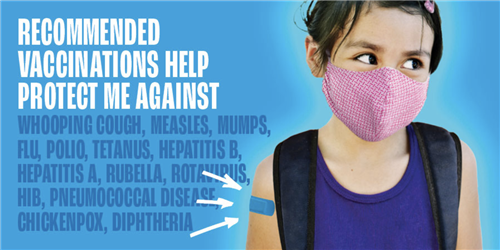Health Services Mission Statement
-
We are committed to meet the health demands, as well as to advance the well-being, academic success, and life-long achievement of our students.
To that end, Health Services facilitates positive student responses to normal human development; promotes health and safety in the school environment; intervenes with actual and potential conditions; provides case management services; and actively collaborates with other district disciplines to build student and family capacity for adaptation, self-management, self-advocacy, and learning.
Health Requirements
-
McHenry District 15 requests parents of students entering pre-school, kindergarten and sixth grade to present documentation that their child has had a physical examination and received required immunizations PRIOR to the opening of the new school year in August.
Students entering pre-school, kindergarten, sixth grade or those entering school at any grade for the first time in Illinois, are required by Illinois School Code to present evidence of a completed physical examination by a licensed physician or a certified nurse practitioner or physician assistant who has been delegated the performance of health examinations by a supervising physician. Additionally, these students must also present evidence of having received immunizations against preventable communicable diseases as required by the Illinois Department of Public Health. In the event that students cannot demonstrate that they have had a physical examination or met the immunization requirements, Illinois School Code requires school districts to exclude students from attending school.All physicals are required to have the parent section completed, including a parent signature.
Need to Find Free Vaccines for Your Child (Not COVID Related)?
The Vaccines for Children (VFC) program provides vaccines to eligible children at no cost. This program provides free vaccines to children who are Medicaid-eligible, uninsured, underinsured, or American Indian/Alaska Native. Check out the program’s requirements and talk to your child’s doctor or nurse to see if they are a VFC provider. You can also find a VFC provider by calling your state or local health department or seeing if your state has a VFC website

Well-Child Visits
-

According to the Center for Disease Control (CDC), children need to be protected against vaccine-preventable diseases. Well-child visits and vaccinations are essential services and help make sure children are protected. Children who are
not protected by vaccines may be more likely to get diseases like measles and whooping cough.
It’s important for parents to work with their children’s doctor or nurse to make sure their children stay up to date on routine vaccines.
When to Keep Sick Children Home From School
-
When to Keep Sick Children Home From School
Deciding when to keep a sick child at home from school is not always easy and has been complicated by the pandemic. In past years, a fever, cough or runny nose was not worrisome and you sent your child back to school when they were well enough to attend. It's important for children to attend school, and for some parents staying home means missing work. But when a child is truly sick, they need to stay home in the care of an adult to get well and to prevent spreading illness to others.
Non-COVID related illnesses may also require your child to recover at home until they are ready to be in the classroom learning.
Your child may be too ill to go to school if he or she has any of these signs (even if COVID negative)- Seems very tired and needs bed rest (this is common with flu symptoms)
- Has vomiting or diarrhea - Your child may return to school when feeling better and has not had vomiting or diarrhea for 24 hours.
- Becomes short of breath or is wheezing
- Has a cough that disrupts normal activity
- Has distracting pain from earache, headache, sore throat or recent injury
- Has yellow or green drainage from eye(s)
- Breaks out in a rash, check with your child's doctor
- Fever; your child should not go to school with a temperature at or above 100.4 F. Your child may return to school when (s)he is feeling better and is fever-free for 24 hours without fever-reducing medications (Tylenol/Motrin, etc.)
Your child should stay home from school if (s)he has a contagious disease. A contagious disease is one that can be spread by close contact with a person or object. Examples are: chickenpox, flu, vomiting, diarrhea, colds, strep throat and "pinkeye."
A disease can be contagious before the child shows signs of illness. It is very hard to prevent the spread of some germs, especially in a school classroom. Good hand washing will help prevent the spread of germs.


Health News
Information on Strep Throat
-
How to reduce strep throat infections at school
IDPH and the CDC are observing an increase in strep throat -- specifically invasive group A streptococcus (iGAS) -- infections among children. ISBE is joining IDPH and and the CDC in stressing the importance of early recognition, diagnosis, and appropriate treatment of these diseases in children and adults.
Find a downloadable fact sheet here.
What Schools Should Do to Reduce Infections
Group A streptococcus bacteria are very contagious. The bacteria that causes strep throat travels in respiratory droplets that are created when an infected person coughs or sneezes. To help reduce strep throat infections, schools and early childhood settings should:
1. Notify parents and provide information on symptoms and encourage parents to promptly communicate with their health care providers when symptoms develop. Share this parent fact sheet.
2. Encourage students and staff to stay home if ill.
3. Encourage parents to bring their children to the doctor to get tested for strep so they can be prescribed the appropriate course of antibiotics and return to school quickly and safely in 24 hours.
4. Educate staff and students on the importance of good hand hygiene (wash hands frequently, especially after coughing, sneezing, eating or preparing food) and cough etiquette. Educate children and staff to avoid touching their hands to their mouths and eyes before handwashing.
5. High touch areas (in classrooms, play areas, cafeterias) should undergo at least daily disinfection in schools seeing cases of strep throat.
Symptoms
The symptoms of strep throat usually include the following:
· Sore throat can start very quickly and can cause severe pain when swallowing.
· Fever.
· Red and swollen tonsils, sometimes with white patches or streaks of pus.
· Tiny red spots on the roof of the mouth.
· Swollen lymph nodes in the front of the neck.
Immunization
-

Who should be immunized? Everyone!
Immunizations, also known as vaccines, are one of our greatest defenses against many serious illnesses. Vaccines are responsible for eradicating diseases such as small pox and polio, as well as reducing cases of measles, diphtheria and pertussis. Illinois state law requires certain immunizations for children and adults enrolled in child care, school, or college. For more information on immunizations visit: http://dph.illinois.gov/topics-services/prevention-wellness/immunization
For local resources on reduced cost/no cost vaccines visit our Health Services Resources page at: https://www.d15.org/Page/408
Keep yourself and your family protected - get immunized!
Key Facts About Influenza and Vaccines
Meningococcal Disease: What Parents and Students Need to Know
Healthful Hints:
-
Kindergarten and 6th grade students, along with all new students from out of state, are required to have a physical examination with completed health history and an up to date immunization record submitted on the first day of school. Please follow the link for resources: https://www.d15.org/
Page/408. You may also contact your school nurse for assistance.



